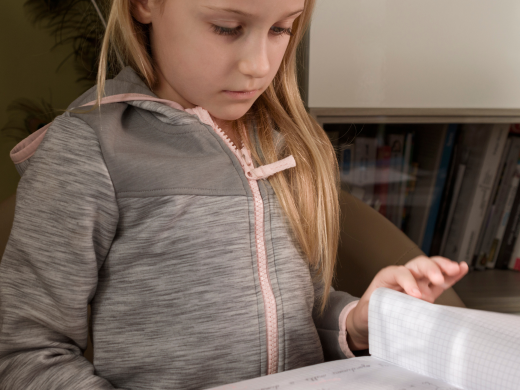
Helping Lily beat the brain bully
Anxiety is a brain bully. In its extreme form it lies, it deceives, and it doesn’t give you a moment of peace, even when sleeping.
Trauma Informed Practice online workshopsBook Now
Half of all mental health conditions have started by age 14*
Yet children under this age historically had limited access to mental health services in Australia.
KidsXpress exists to ensure that children are getting the help they need, in the way they need it and when they need it.
Childhood mental health issues often arise from experiences of trauma and a stressful home environment. Our trauma-informed Expressive Therapy and Education services combine psychology and the creative process to support primary school-age children and their caregivers.
(*Kessler, R.C., et al., Lifetime prevalence and age-of onset distributions of DSM-IV disorders 2005).
Half of all mental health conditions emerge before age 14*, yet signs of a struggling child often go unnoticed. It can sometimes be challenging to distinguish between typical childhood behaviours and signs of underlying mental health concerns. While children naturally go through various emotional and behavioural changes as they grow, there are some signs that suggest there may be a need for closer attention. Early action is key to prevent issues growing with a child into adulthood. Our resource guide is a great starting point.
(*Kessler, R.C., et al., Lifetime prevalence and age-of onset distributions of DSM-IV disorders 2005).
Download Free GuideMental ill-health affects 1-in-7 Australian children, yet fewer than 25% are accessing care.
Without support, the impact of their condition can grow with them into lifelong challenges. We’re on a mission to change that.
students were reached by us in 2023 through our School Partnership Program.
teachers were supported through our School Partnership Program in 2023.
of children who attended KidsXpress identified positive change in themselves.
(CORS, 2023 Term 2)
is our cost benefit ratio, meaning that for every $1 invested in KidsXpress a return of $2.76 is generated in social value.
(DAE, 2015, p.46)
Babies are born with a natural inclination to seek out and respond to social cues from their caregivers. This sensitivity is rooted in their evolutionary history, where the ability to interpret facial expressions and tone of voice played a critical role in survival and social bonding. Smiling at your baby not only conveys positive emotions but also signals safety and security, activating neural pathways associated with feelings of comfort and connection. This early interaction helps to shape the infant`s perception of the world and lays the groundwork for healthy emotional development and secure attachment relationships.
#childdevelopment #parenting #parentingtips #attachmenttheory

Ever wonder why children always say, `Hey mum, dad, watch this!` when trying something new? It`s more than just seeking attention – it`s deeply rooted in their psychological development. When kids utter these words, they`re not just seeking a fleeting glance; they`re craving validation and connection. This act reflects their innate need for approval and affirmation from their caregivers, which plays a crucial role in their emotional development.
From a child psychology perspective, this behaviour stems from the concept of attachment theory. Children naturally seek reassurance and support from their primary caregivers, using moments of accomplishment as opportunities to strengthen their bond. Saying `watch this` is their way of inviting you to share in their joy and success, solidifying the connection between parent and child.
So, the next time your little one calls out, take a moment to watch, cheer them on, and show them that you`re their biggest supporter! Here are some examples of responses you might say:
1. `I love seeing you try new things, you`re so brave!`
2. `You`re really good at that, I can tell you`ve been practicing!`
3. `I`m impressed by your creativity and determination!`
4. `You`re making it look so easy, great job!`
5. `I can see how much fun you`re having, that`s wonderful!`
By acknowledging their efforts and celebrating their achievements, you`re not just witnessing a simple act, you`re nurturing their sense of self-worth and building a foundation of trust and confidence that will serve them well into adulthood.
#childpsychology #emotionaldevelopment #parentingtips #childmentalhealth

This is why it matters!

Understanding the profound impact of parental communication on children`s emotional development is vital. Using guilt-inducing statements such as `it makes me sad when you don`t listen` can inadvertently teach our kids that their behaviour is responsible for our emotions, leading to confusion, anxiety and guilt.
Other examples include: "If you loved me, you would do this for me" or “if you don’t hurry up, you’ll make me late for work and I’ll lose my job” or “I could do that when I was your age, why can’t you?”.
These kind of statements can create feelings of inadequacy and pressure the child to comply. It’s a misuse of power dynamics and can undermine trust which in turn hinders the development of healthy emotional regulation skills.
Instead of using emotional manipulation, we should try to employ positive reinforcement techniques to encourage our children to listen. For example, we can praise our children when they listen attentively or follow instructions promptly. Additionally, setting clear expectations and providing consequences for not listening can help reinforce the importance of active listening skills. By emphasising the positive outcomes of listening and providing consistent reinforcement, we ensure our children listen without resorting to emotional manipulation.
#childdevelopment #emotionalregulation #parenting #parentingtips #childmentalhealth

Childhood trauma doesn`t always mean what we think it does. It means navigating through adverse experiences during formative years that overwhelm a child`s ability to cope. It encompasses a range of events, from neglect and abuse to feeling like our emotional needs weren`t met. Understanding its formal definition and the range of experiences it encompasses is crucial in recognising its lasting effects and paving the way for healing and resilience.
#childhoodtrauma #ACEs #child
